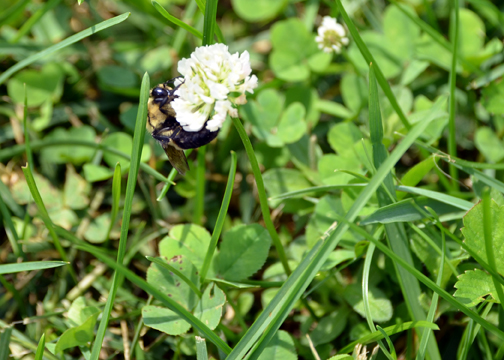UK researchers find pesky lawn weeds good for pollinators
UK researchers find pesky lawn weeds good for pollinators

For many homeowners, dandelions and white clover are nothing more than a nuisance, but University of Kentucky entomology researchers have found they are a welcome presence to many pollinator species.
UK entomologist Dan Potter and Jonathan Larson, University of Nebraska extension entomologist, then a UKAg doctoral student, sampled the weeds for bees and other pollinators in Central Kentucky lawns in the spring and summer of 2011 and 2012. Their goal was to identify pollinator species that could be affected if the weeds were accidentally sprayed with lawn insecticides. These lawn weeds bloom around the same time insecticides to control pests, such as grubs, should be applied. Lawns in the study were comprised of about 30 percent weeds.
“In the spring, a lot of native bees that are foraging on these weeds are queens and are very vulnerable, as their colonies are not yet established,” said Potter, a professor in the UK College of Agriculture, Food and Environment. “If someone’s lawn is treated with certain insecticides in April or May and the bees come in contact with residues on weed blooms, then they’ve not only lost that colony but the potential for reproduction for next year.”
In addition, UK researchers tested whether bee species collected in urban and suburban lawns were just as numerous and diverse as bee species collected from rural lawns.
Larson and Potter collected and identified more than 2,100 total pollinators. Those pollinators were from 50 different species, including 37 bee species. Scientists consider two of the bumble bee species they found uncommon and possibly declining in population.
The most common species collected from dandelions were hover flies, honey bees, and wild native bees. Honey bees and native bumble bees were the most common visitors to white clover, especially during the late summer. They collected several species of butterflies including the common buckeye and fritillaries on the white clover in the late summer.
Larson and Potter found just as many pollinator species visiting urban and suburban lawns as visiting lawns in rural settings.
“I hope we are able to raise awareness of the numerous beneficial bees in our lawns and that a patch of clover can be beneficial, because those bees are the ones pollinating our gardens, flowers and trees that provide not only food for us, but for a variety of urban wildlife like birds,” Potter said.
Their paper was recently published in the Journal of Insect Conservation.
In a related study in 2013, Larson and Potter found that mowing down flowering weeds before or soon after treating a lawn for grubs or other pests greatly reduces bees’ exposure to the insecticide. Homeowners should read and follow the label directions when using any pesticide.
Entomology Research



